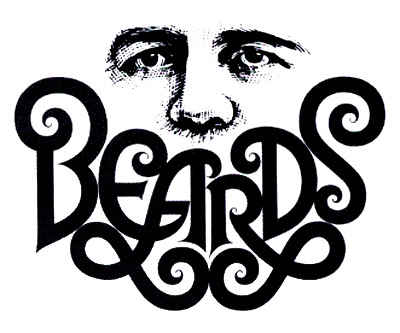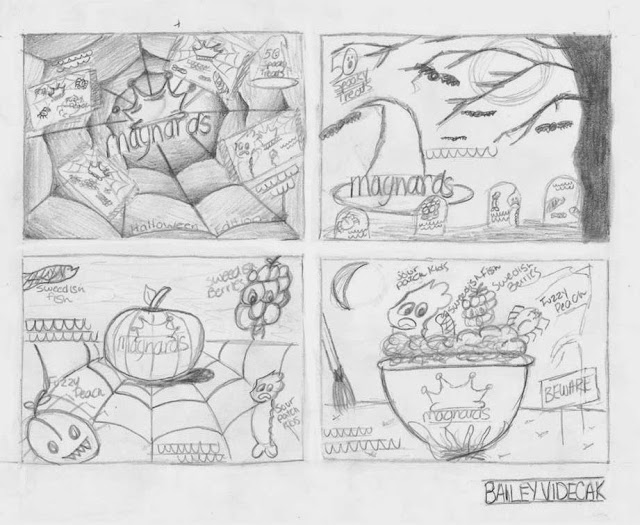*Note: This week's in-class assignment has two parts.
Part 1: Drawing the Head by Construction
Begin with an 8 1/2 x 11 inch sheet of white paper turned horizontally in front of you on your drawing table. As always, draw (freehand) a 1" border all the way around the page and hand-letter your name between guidelines at bottom right.
Again, working only freehand, sketch a circle in the top LH quadrant of the page as shown. The exact size and placement isn't important. Just try to approximate what you see in this example. Lightly draw guidelines dividing the circle in half both vertically and horizontally.
Extend vertical guidelines down from both sides of the circle, allowing them to taper inward slightly as shown. Extend the centre guideline down as well. Using the half circle as a unit of measure, lightly mark a guideline below the circle so that you have three equal units in height. This is the total height of the head, from the top of the skull to the chin.
Lightly sketch in guidelines 1/3 of the way down from the top of each unit of measure as shown. Note that each guideline represents a landmark on the face, from the top of the head to the chin.
Important: Note that the centre horizontal line of the circle if the brow line, NOT the eye line, which is 1/3 below the brow line. Also note the bottom of the circle is the bottom of the nose and that the mouth is 1/3 the distance to the chin - not halfway!
Here's a little trick: if you draw five equal sized ovals touching end to end across the width of the circle on the eye line, the
second and
fourth ovals are the correct size and shape for the eyes.
Lightly draw guidelines straight down from the centre of each eye to arrive at the corners of the mouth. This is how you establish the width of the mouth.
Since we are drawing a male head, do NOT draw the lips all the way around! Look at how I drew the line for the opening of the mouth and try to mimic it. Add just a sketchy line under the mouth. this represents the shadow under the bottom lip.
Draw a triangle from the centre point of the eye line to the corners of the mouth. point where the sides of the triangle cross the nose line (the bottom of the circle) represent the width of the nose.
Also note how I have drawn angled lines from the side guidelines at around the mouth line to complete the chin. On a male face, always use angled lines, not smooth curves.
Try to draw the nose in the manner shown. A dip in the centre, slight upwards curves for the nostrils, then curved verticals for the outsides of the nostrils.
Extend the eye and nose guidelines outward a bit at both sides of the head. This gives you the height of the ears. Draw a shallow "C"- shaped curve for the outside shape of the ear.
Try adding the interior ear lines as I've indicated. You can now heavy up the eyebrows 9use angular lines as shown) and the top lip and bottom lip shadow, also as shown.
Now extend all the horizontal guidelines across to the right side of the page.
Draw another circle on the right side in the same position as the one you first drew on the left side. This time when you extend guidelines down on both sides of the circle, taper them in a bit more, as shown.
repeat the facial construction steps you used on the male face, as shown.
Notice the female eyebrows are curves, not angles, the eyelashes are long, elegant curves, the lips are drawn all the way around (top lip is a bit smaller than the bottom lip) and the chin is one long curve, no angles.
Finish the eyes, ears and nose as shown.
Part 2: Drawing the Body by Construction
Begin as always by drawing a freehand border 1" in from the outside. This time we're working vertically. Don't forget to hand-letter your name in the lower RH corner as shown.
Draw a straight line (freehand) that goes nearly from the top border to the bottom border, as shown. You'll need to divide the line into eight equal units so begin by visually locating the centre point and lightly sketch a mark there.
Now divide the two equal units in half, creating four equal units.
Now divide the four, creating eight equal units.
Each of these eight units represents a landmark on the body, from head to toe. Draw guidelines across the page and mark off each guideline as shown. Draw a new vertical line on the RH side of the page. this will represent the centre of the body.
In the top unit, draw the head using construction measurements from Part 1. (No need to add details of the face)
Use the width measurement of the head to arrive at the total width of the entire form. Add the width of the head again to either side of the head and draw guidelines all the way down to the base line of the figure.
Measure in approximately 1/3 of one head width on the left and the right and draw guidelines to the base of the figure. measure down approximately 1/3 of the distance from the chim to the nipples to establish the shoulder line.
Locate the navel on the navel line, then draw a triangle to the corners of the shoulders. As the two sides of the triangle pass across the nipple line, they provide the location of the nipples. Darken the centre line from the crotch to the base line. This establishes the two leg shapes. Add the knee caps and ankles as shown.
Begin breaking down each unit with ovals as shown to establish the general shapes of each body part.
Refine and connect all the body parts as shown.
Using the information you learned in this week's exercises, draw a full standing (clothed) figure of anyone you like, real or imaginary. Indicate the measurements to one side of the figure as in the exercise. Label all the proportions as in the exercise. Show all construction lines as in the exercise - THEN draw the clothing over top. DON'T erase the underdrawing!















































